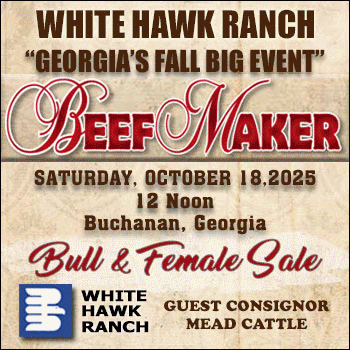LIVESTOCK & POULTRY:
Total U.S. red meat and poultry production for 2026 is forecast lower than in 2025. Beef production is forecast lower on tighter cattle supplies, fewer available fed steers and heifers due to import restrictions on cattle from Mexico, and reduced slaughter of cattle. Pork production is forecast higher on increased hog supplies, primarily driven by steadily increasing rates of pigs per litter, as well as higher dressed weights. Broiler production is forecast to increase on favorable producer returns. Turkey production is also forecast to increase on improved producer returns and recovery from Highly Pathogenic Avian Influenza (HPAI)-related culls. Egg production is forecast to increase in 2026, as layer inventories continue to rebound from their HPAI-related contraction from late 2024 and early 2025. Total red meat and poultry production forecasts for 2025 are reduced from last month, with beef, broiler, pork, and turkey production all forecast lower. The beef production forecast is lowered as higher dressed weights more than offset reduced steer and heifer slaughter due to the suspension of cattle imports from Mexico. Pork production is reduced on a slower rate of slaughter expected for the second half of the year although it is slightly offset by increased production in the second quarter. Broiler production is reduced on official data reported for the first quarter of 2025, with the reductions carried forward for the remainder of the year. Turkey production is also reduced based on official first-quarter data. The egg production forecast is reduced on recent data on layer inventory and egg production.
For 2026, beef exports are forecast lower than the current 2025 forecast, as tighter domestic supplies reduce international competitiveness. Pork exports are forecast to increase, in line with higher production. Broiler exports are higher due to increased supplies, although growth is expected to be constrained by robust domestic demand and international competition from other major exporters. Turkey exports are forecast to increase on higher supplies.
For 2025, beef exports are reduced from the previous month, as higher-than-expected official reported trade data for the first quarter is more than offset by tighter available supplies for the second half of the year. Pork exports are raised on higher first-quarter results, with improved export demand carried into the second half of the year. Broiler exports are also raised on recent trade data and improved export demand for the remainder of 2025. Turkey exports are reduced, primarily on lower first-quarter data. Cattle prices in 2026 are forecast to be above 2025 on tighter cattle and beef supplies. Hog prices are forecast to be lower in 2026 on increased hog supplies. Broiler prices are forecast higher on robust demand for chicken. Turkey prices are forecast higher as well, continuing the recovery expected during 2025.
Cattle price forecasts in 2025 are raised from last month on recent price strength seen through early May and tighter fed cattle supplies expected during the second half of the year. The broiler price forecast is raised slightly on recent price strength. The turkey price forecast is also raised on higher prices reported through early May and tight supplies. Hogs price forecasts are adjusted to reflect the net price published for Producer Sold barrows and gilts in the USDA’s Agricultural Marketing Services’ National Daily Direct Hog Prior Day Report.
COARSE GRAINS:
The 2025/26 U.S. corn outlook is for record supplies and total use, and higher ending stocks. The corn crop is projected at 15.8 billion bushels, up 6 percent from a year ago on increases to both area and yield. Planted area of 95.3 million acres if realized would be the highest in over a decade. The yield projection of 181.0 bushels per acre is based on a weather-adjusted trend assuming normal planting progress and summer growing season weather. With smaller beginning stocks partially offsetting the increase in production, total corn supplies are forecast at 17.3 billion bushels.
Total U.S. corn use for 2025/26 is forecast to rise over 1 percent relative to a year ago on higher domestic use and exports. Food, seed, and industrial use is forecast at 6.9 billion bushels. Corn used for ethanol is unchanged relative to a year ago at 5.5 billion bushels, based on expectations of essentially flat motor gasoline consumption and exports. Feed and residual use is projected higher to 5.9 billion bushels on larger supplies and lower expected prices.
U.S. corn exports for 2025/26 are forecast up from a year ago to 2.7 billion bushels, with lower prices driving a forecast increase in world trade. Exports for competitor countries such as Argentina and Ukraine are higher than a year ago. For Brazil, expectations of continued domestic demand growth limit expansion in exports. The United States is projected to be the world’s largest exporter, with fractional decline in global market share.
With total U.S. corn supply rising more than use, 2025/26 ending stocks are up 385 million bushels from last year and if realized would be the highest in absolute terms since 2019/20. Stocks would represent 11.6 percent of use, up from 9.3 percent the prior year. The season-average farm price is projected at $4.20 per bushel, down 15 cents.
WHEAT:
The 2025/26 U.S. wheat outlook is for increased supplies, modestly higher domestic use, reduced exports, and higher stocks. Supplies are projected up 2 percent from 2024/25 as higher beginning stocks more than offset lower production. All wheat production is projected at 1,921 million bushels, down 3 percent from last year on lower harvested acreage. The all wheat yield is projected at 51.6 bushels per acre, up 0.4 bushels from last year. The first 2025 NASS survey-based winter wheat production forecast of 1,382 million bushels is up 2 percent from 2024 with Hard Red Winter and White accounting for most of the increase. Total 2025/26 domestic use is marginally higher, mostly on food use, which is projected at a record 977 million bushels. Exports are projected lower at 800 million bushels as the United States is expected to face strong competition from most major exporters in 2025/26. Projected 2025/26 ending stocks are 10 percent above last year at 923 million bushels, the highest level in six years. The projected 2025/26 season-average farm price is $5.30 per bushel, down $0.20 from last year on higher stocks and lower projected U.S. corn prices.
View Complete Report
Articles on The Cattle Range are published because of interesting content but don't necessarily reflect the views of The Cattle Range.















